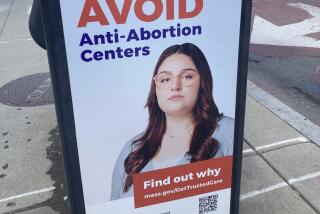Opinion: Abortion clinic buffer zones should be protected by the Supreme Court
Within days, the justices of the Supreme Court will hand down their ruling on the constitutionality of buffer zones at abortion clinics, and I hope they will remember that these zones came out of a desire to prevent violence and harassment, not to hinder free speech.
Last weekend was the fifth anniversary of the death of Dr. George Tiller, an abortion provider at a clinic in Wichita, Kan., who was shot and killed as he attended church services. His killer is serving a life sentence. It’s a reminder that violence sometimes stalks doctors who perform abortions and the staff who assist them at clinics in some parts of the country.
The case before the Supreme Court involves a controversial Massachusetts law that says no person may enter or remain in the 35-foot buffer zones set up outside abortion clinics in the state. Two other states have protective zones. Fifteen states and the District of Columbia have prohibitions on acts such as blocking entrances to clinics, intimidating staff and patients and making excessive noise outside clinics.
The Massachusetts law was passed after two clinic workers in Brookline were fatally shot in 1994 by an abortion rights opponent. And the Guttmacher Institute, a research organization that supports reproductive health services, reports that family planning clinics continue to report incidents of bombings, arson and vandalism as well as violent protests.
Of course, a buffer zone law would not have kept Tiller from being gunned down in his church in 2009. But the reality of abortion rights opponents engaging in disruptions or intimidation of abortion providers and their patients means it is prudent to have such zones.
I believe the Massachusetts law is not an onerous restriction on 1st Amendment rights. As The Times editorial board argued in December, the Massachusetts buffer zone is justifiable as a protection against possible violence — and we know there are people who have been violent, who have turned reproductive health clinics into battlegrounds.
Abortion opponents complain that they are held so far back from the entrances to clinics that they can’t speak to a woman in a conversational tone of voice and make eye contact. But there’s nothing in the 1st Amendment that guarantees access to intimate conversation. Nor does this law prevent a woman on her way into a clinic from choosing, herself, to stop and speak to a person in the buffer zone.
The point is that women walking into a clinic are exercising their constitutionally protected right to an abortion. And neither they nor anyone assisting them or working in those clinics should be attacked or harassed in the process.
More to Read
A cure for the common opinion
Get thought-provoking perspectives with our weekly newsletter.
You may occasionally receive promotional content from the Los Angeles Times.











